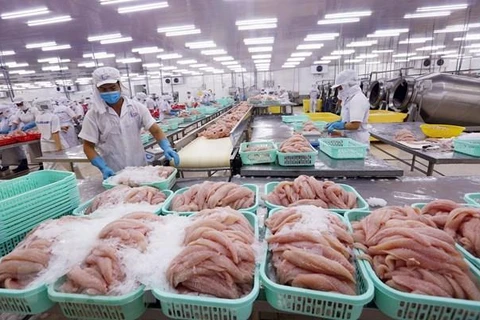Hanoi (VNS/VNA) - Vietnam’s export of aquatic products in July showed positive signs with an increase of 9 percent year-on-year, particularly with exports of shrimp and other products rising, except for pangasius.
As a result, the country’s total seafood export turnover in the first seven months of 2019 reached 4.7 billion USD, nearly equal to the same period last year, reported the Vietnam Association of Seafood Exporters and Producers (VASEP).
After continuous declines in the first months of the year, shrimp exports began to recover in July with an increase of 13.4 percent and reached 334 million USD. Enterprises boosted sales to all major markets. Exports to the US increased by 37 percent, China 48 percent, and Australia 56 percent. In particular, the average export price to the US decreased by 1.1 USD per kilo over the same period last year.
For China, the Government is tightening trade and increasing food safety control, so cross-border exports are not acceptable. However, official exports by sea tended to increase.
From June, the white-leg shrimp exported by sea to China increased by 1.5 times compared to the previous month. VASEP forecasts that this trend will continue to bring positive results in the last months of the year.
In contrast, shrimp exports to the EU fell by 21 percent. Of which, the main consumption countries such as the UK, Germany and the Netherlands recorded a decrease of 5 percent, 9 percent and 45 percent, respectively. Average selling price decreased by 1 USD per kilo against the same period last year.
In Japan, export volume remained stable and market demand did not increase. However, the average price decreased by 1 per kilo, from 12 USD to 11 USD, causing the total turnover to drop by nearly 3 percent to 329 million USD in July.
According to VASEP, pangasius exports continued to fall by nearly 13 percent in July, pushing the total export turnover in the first seven months down by 5.5 percent to 1.13 billion USD.
In the US, after falling nearly 28 percent in the second quarter due to the impact of the 14th administrative anti-dumping review, sales to this market in July decreased by 56 percent.
Exports to other markets also reversed, of which sales to the EU decreased by 16 percent, to ASEAN by 14 percent, Mexico by 28 percent and Brazil by nearly 30 percent. However, exports to China recovered remarkably, rising by 71 percent in July.
In July, tuna exports maintained a growth of 16 percent thanks to demand from the US and Japan but decreased by 2.5 percent with squid and octopus.
The illegal, unreported and unregulated (IUU) yellow card continues to affect seafood exports to the EU market. In addition, the issue of inadequate confirmation and certification of exploited and imported materials causes exports to stall. As a result, tuna exports to EU decreased by 20 percent while octopus and squid exports increased by 12 percent.
For the US, tuna exports increased by 61 percent, and octopus and squid increased by 60 percent. The US is also the largest market of Vietnamese tuna, accounting for 43 percent of total export turnover to other markets.
For Japan, tuna exports also recovered with an increase of 85 percent in July.
VASEP forecasts that shrimp exports are more positive in the US, China, and Japan markets in the last months of the year when inventories decrease, demand increases and shrimp quantity in India may drop by 20-30 percent due to the weather and falling prices.
With pangasius, the association predicts that exports will increase strongly in the last months, because export enterprises have caught up with the requirements of Chinese product quality safety regulations.
Export of tuna is also forecast to continue growing well in the second half of the year in the US and China markets. However, the EU market will be difficult to predict because it depends on the results of EU inspections at the end of October regarding the implementation of recommendations against IUU exploitation.
According to VASEP, in the next few months, businesses may continue to boost sales to this market. If there are positive results after the inspection, exports will improve.
Businesses can also boost sales to markets outside the EU. Exports are expected to maintain positive growth in the last months of the year. - VNS/VNA
VNA

























